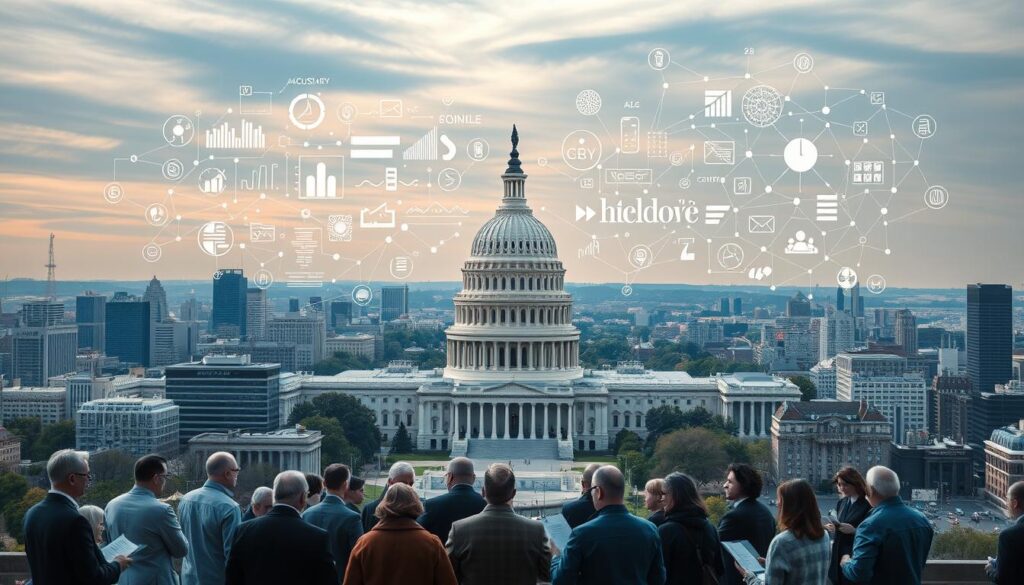What if the rules shaping tomorrow’s technology are being written faster than the innovations themselves? Governments worldwide now face an unprecedented challenge: balancing rapid technological progress with safeguards for society. Over 2,000 governance initiatives have emerged globally, reflecting a surge in legislative urgency. In the U.S. alone, lawmakers proposed more than 700 bills related to advanced systems in 2024—a pace accelerating into this year.
The current landscape resembles a complex patchwork, with policies varying wildly across borders. This fragmentation complicates compliance for organizations operating internationally. For example, global governance frameworks often clash with regional mandates, creating hurdles for businesses and developers alike.
This article unpacks how nations are approaching oversight in 2025. From federal proposals to state-level experiments, the focus remains on harmonizing innovation with accountability. Why does this matter? Without cohesive standards, industries risk inconsistent enforcement and delayed breakthroughs.
Key Takeaways
- Over 2,000 governance initiatives exist globally, signaling intense regulatory activity
- U.S. legislative proposals surged by 40% in early 2025 compared to prior years
- Divergent regional policies create compliance challenges for multinational organizations
- Balancing innovation and risk mitigation remains a core focus for policymakers
- Understanding these patterns is critical for tech leaders and legal teams
Overview of the Global AI Regulation Landscape

Navigating the labyrinth of global standards for advanced technologies has become a defining challenge for policymakers and corporations alike. Over 60% of multinational enterprises report compliance costs doubling since 2023 due to conflicting national requirements. This complexity stems from varying priorities: some governments emphasize innovation incentives, while others prioritize public safeguards.
Why Governance Matters Now
Effective oversight determines how societies harness technological potential while minimizing harm. Recent incidents involving biased decision-making systems and data leaks underscore the stakes. International bodies like the OECD and U.N. now advocate for shared principles, including audit trails and impact assessments.
Divergent Paths, Shared Challenges
Three distinct regulatory approaches have emerged globally:
- Risk-based categorization (EU’s AI Act model)
- Sector-specific guidelines (common in Asia-Pacific countries)
- Voluntary certification programs (favored by some U.S. states)
New evaluation tools like HELM Safety help organizations verify systems’ factual accuracy. However, only 18% of tech firms consistently apply these benchmarks. For those navigating financial sector compliance challenges, alignment between regional policies remains elusive.
AI regulation trends 2025: U.S. Policy Developments

American policymakers face mounting pressure to redefine oversight frameworks for emerging technologies. The absence of unified federal legislation has created a dynamic environment where executive actions and state experiments shape national strategy.
Existing Federal Laws and Executive Orders
January 2025 marked a pivotal shift in Washington’s approach. The new administration replaced previous safeguards-focused directives with Executive Order 14112, prioritizing technological leadership through deregulation. This reversal impacts three key areas:
- Reduced compliance requirements for defense-related systems
- Streamlined approval processes for aviation technologies
- Revised national strategy implementation guidelines
Sector-specific laws like the FAA Reauthorization Act now serve as primary governance tools. However, gaps persist in consumer protection and ethical standards for commercial applications.
State-Level Innovations and Legislative Dynamics
Regional governments are filling federal voids with targeted measures. California recently mandated impact assessments for public-sector technologies, while Colorado introduced financial sector compliance rules for automated decision-making systems.
This decentralized approach raises questions about interstate coordination. As state legislatures accelerate proposals, businesses must navigate conflicting requirements across jurisdictions.
State-Level Legislation and the Regulatory Patchwork

State governments are now at the forefront of crafting rules for emerging technologies. This decentralized approach creates both opportunities for innovation and challenges for nationwide operations. At least 18 states have introduced governance frameworks since 2023, each prioritizing distinct safeguards and transparency requirements.
Case Studies: California, Colorado, and New York
California’s 2024 legislative package sets benchmarks for multiple industries. The Defending Democracy from Deepfake Deception Act combats election misinformation, while the Health Care Services Act mandates transparency in medical decision-making systems. Colorado’s pioneering 2024 law imposes strict accountability for high-risk tools affecting education and housing without revenue exemptions.
| State | Key Legislation | Focus Area |
|---|---|---|
| California | Digital Replica Act | Entertainment industry protections |
| Colorado | AI Act | Bias prevention in critical services |
| New York | Pending Assembly Bill 5673 | Public sector impact assessments |
Balancing Uniformity and Local Autonomy
Utah’s tiered disclosure rules exemplify how states adapt frameworks to local needs. Licensed professionals face stricter mandates than general businesses under its 2024 Policy Act. However, this variability complicates educational technology standards and healthcare operations across state lines.
Connecticut and Texas have established working groups to evaluate agency use of automated tools. These efforts highlight the tension between standardized practices and regional priorities in governing advanced systems.
International Perspectives on AI Regulation Frameworks
Global governance strategies reveal striking contrasts in how nations manage emerging technologies. While some prioritize innovation, others enforce strict safeguards. This divergence creates both opportunities and hurdles for multinational enterprises.
European Union and the AI Act Model
The EU’s risk-based approach categorizes technologies by potential harm levels. High-risk systems face rigorous testing and documentation rules. For example, facial recognition tools require third-party audits before deployment.
Asia-Pacific and Other Regional Approaches
China mandates content labeling for generated media through four specific laws. South Korea’s Basic AI Law introduces mandatory impact assessments starting January 2026. Singapore tailors rules for financial institutions, requiring bias checks for loan algorithms.
| Region | Framework | Focus |
|---|---|---|
| European Union | AI Act | Risk-tiered compliance |
| China | Deep Synthesis Rules | Content transparency |
| South Korea | Basic AI Law | System accountability |
| Singapore | MAS Guidelines | Financial sector safety |
Australia invests in workforce training through its Capability Plan. Japan provides non-binding safety checklists for manufacturers. These differences complicate global compliance strategies but offer varied innovation pathways.
Ethical Concerns and Transparency in AI Systems
How do we ensure machines make decisions aligned with human values? This question drives global conversations about accountability in automated systems. Over 70% of tech leaders now prioritize ethical frameworks, yet implementation gaps persist between corporate pledges and operational practices.
Responsible AI: The Role of Ethical Standards
The White House Blueprint outlines five core principles for responsible development:
- Safety validation through rigorous testing
- Protection against biased outcomes
- Clear user notifications about data usage
- Accessible human oversight options
- Privacy safeguards for sensitive information
Major companies like Google and Microsoft have adopted these guidelines voluntarily. However, only 34% conduct third-party audits to verify compliance. New tools like HELM Safety help assess factual accuracy, but adoption remains inconsistent across industries.
Guidelines for Transparent AI Operations
Transparency requires detailed documentation of how systems process data and reach conclusions. For example, healthcare algorithms must disclose training sources and decision thresholds. Financial institutions using credit-scoring tools now face mandates to explain denial reasons in plain language.
Challenges emerge when technical explanations confuse non-expert users. Collaborative efforts between developers, regulators, and ethicists aim to create standardized disclosure formats. As one industry report notes: “Clarity builds trust—but only if stakeholders understand what’s being revealed.”
Risk Management and Safety in AI Deployment
As automated tools reshape high-stakes industries, organizations face mounting pressure to prevent operational failures. Recent data shows a 58% increase in technology-related incidents since 2023, with healthcare and finance sectors accounting for 41% of reported cases. This urgency drives new approaches to identifying vulnerabilities before deployment.
Sector-Specific Threat Analysis
Critical industries require tailored assessment strategies. Financial institutions now conduct mandatory bias checks on credit algorithms, while healthcare algorithms undergo multi-phase clinical validations. The Federal Trade Commission’s ban on Rite Aid’s facial recognition systems illustrates consequences of inadequate safeguards—a precedent influencing retail and security sectors.
Building Reliable Validation Frameworks
Effective protocols combine technical rigor with operational transparency. Singapore’s financial authority mandates quarterly audits for loan approval systems, requiring detailed documentation of decision logic. Leading enterprises adopt three core practices:
- Real-world scenario stress testing
- Cross-functional review panels
- Continuous monitoring dashboards
These methods help address 73% of identified system flaws during development phases. As tools grow more complex, collaborative efforts between engineers, legal teams, and community stakeholders become essential for sustainable innovation.







